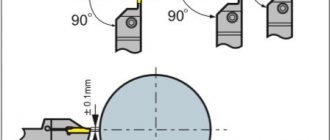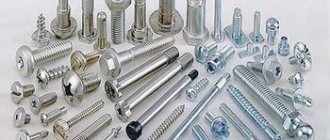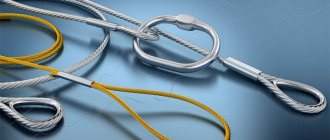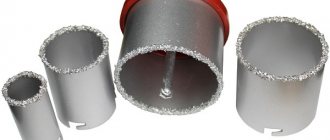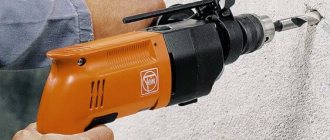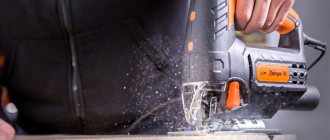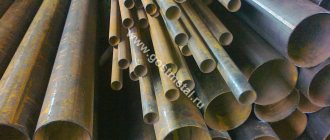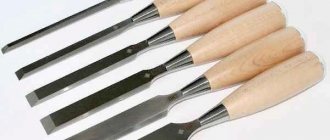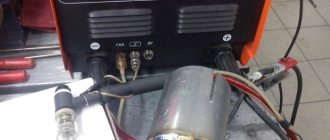Even minor repairs, not to mention professional construction, cannot be completed without the use of a hammer drill. It is with its help that you can make a hole in a stone wall or a recess in a concrete structure. Therefore, both the home craftsman and the builder should know how to work with a hammer drill.
Also, such a tool allows you to quickly and easily drill the required number of holes in ceramic tiles, brick, wood, and metal. And additional attachments will allow, for example, to drill through a ceiling, compact material, drive a rod, and even tighten a screw.
Depending on the application and the availability of additional components, the hammer drill can be used in a wide variety of construction operations. But how to do this correctly to prevent tool failure?
For what materials can a hammer drill be used:
- Is it possible to tighten screws and self-tapping screws with a hammer drill ? Many professional builders prefer, whenever possible, to use power tools that can perform the functions of several types of equipment. A hammer drill is one of them. To quickly and conveniently screw in self-tapping screws, special attachments are used. Among them there are models with a limiter, which guarantee control of the “recession” of fasteners.
- Is it possible to mix the solution with a hammer drill ? It is possible, and quite effective, with low viscosity of the solution (for high-viscosity formulations, it is recommended to use a stirrer attachment and work at minimum speed). Additional arguments in favor of this use may be that the speed of rotation of the tool shaft can be easily changed. In addition, according to the principle of its operation, a hammer drill differs little from a construction mixer.
3. Is it possible to drill wood with a hammer drill? Using a hammer drill you can get fairly high-quality holes. To do this, you need to use a power tool in drill mode and use special drills. Depending on the material and diameter of the hole, the drilling speed is determined.
4. Is it possible to drill tiles with a hammer drill? The main problem when working with ceramics is that it can break if handled incorrectly. That is why, when using a hammer drill, you must first turn off the impact mode, and it is better to start drilling at low speeds with a gradual increase in speed.
5. Is it possible to drill metal with a hammer drill? If you use a special drill, it is possible to create holes with this tool in almost any material. In most cases, they have a cylindrical shank and a spiral design. The material for their manufacture is high-strength steel (often based on cobalt alloys). Drills equipped with carbide plates on the cutting part will be more universal in use.
It will be interesting: “What is the difference between an impact drill and a hammer drill: 7 main criteria”
What is a hammer drill used for?
The tool is designed to perform percussion work in hard materials :
- stone;
- metal;
- brick;
- reinforced concrete.
A hammer drill is a universal tool.
It is used to drill holes of different diameters for dowels, sockets for sockets in concrete, chip tiles, break through floors, as well as concrete and brick walls, and make openings for laying communications.
The versatility of the hammer drill is explained by the ability to work in various modes :
- drilling;
- rotation with and without impact;
- hit without rotation.
Professional models can work like a jackhammer.
When can you work with a hammer drill?
To avoid problems with neighbors during repairs, you should focus on the following standards for permissible noise levels.
| Types of noise | Usage time | |
| Listen to music loudly, use household appliances that produce high noise levels: | From 8:00 to 22:00 | |
| Repair work involving the use of noisy equipment (or vibrator grinders, jackhammers, etc.) | work days | From 8:00 to 21:00 |
| holidays, weekends | forbidden | |
Preparing the hammer drill for work
Before drilling with a hammer drill, you need to prepare for work, study the instruction manual and strictly follow the requirements described in it. If the rules are violated, the instrument may break and it is not always possible to repair it. The required load must not be exceeded. Long and continuous operation leads to overheating of the gearbox and drive elements, which fail. Parts are lubricated only with high-quality compounds . It is prohibited to perform work that is not provided for in the instructions. Before drilling into a wall with a hammer drill, it is inspected.
Check integrity:
- housings;
- cartridge;
- electrical insulating layer of the connection cable.
It is necessary to make sure that there are no chips or cracks on the crowns, drills and drills. The cutting edges must be sharpened.
Before drilling a hole with a hammer drill, perform a trial run and operate in idle mode . Check whether the buttons and toggle switches responsible for the speed and direction of rotation of the cartridge work.
On an unfamiliar object, make sure that the wiring is of sufficient size to power a powerful tool. Otherwise, the cable will overheat, which will lead to melting of the insulation and short circuit.
Is it possible to completely refuse to have a screwdriver if you have a hammer drill?
A hammer drill has many advantages over a screwdriver. However, this does not mean that you should abandon the impact drill. If you don’t have it at hand, then a hammer drill can very well become a replacement, but it all depends on the goals and objectives that you set for yourself.
It is also worth considering the type of material you plan to work with. For example, it is recommended to work with wood and metal only with a screwdriver. If the material is not super strong and hard, you can use it just fine. The cost of a drill is several times lower than that of a hammer drill, and this is also its advantage.
In other cases, you should turn to a hammer drill for help. After all, although a screwdriver is suitable for simple tasks, its power is not enough for more complex ones. However, you can also use a hammer drill to perform some light functions. If this does not violate the operating rules.
Features of drilling different surfaces
There are as many varieties of materials as there are drilling features. High-quality results can only be expected if they are strictly followed.
Metal
This material is difficult to handle mechanically. You need to work with metal with very strong, high-quality drills , otherwise the workpiece can be damaged. It is extremely difficult to drill into thin metal sheets. They move all the time. A special device is used to fix them.
For metal use especially strong drills
Tree
Wood is easy to drill and chisel, but when working with it, certain requirements must be observed. Logs must be secured. When working with small wood, use simple sandpaper. Wrap the blanks in felt. It will help remove burrs that appear after drilling. When working with wood, do not put too much pressure on the tool. There are several types of wood flooring, each treated differently. For example, when drilling plywood, to prevent it from splitting, use an attachment resembling a potato peeler. To make one, a steel tube . They use it to make holes in the plywood.
Wood of different species varies significantly in hardness . As a result, the load on the equipment when working with pine is less than with oak. It must be borne in mind that the resulting chips clog the drill, which can cause it to overheat.
The store sells a large number of different products. Don't buy the cheapest ones. They are not reliable. They can be purchased to perform one-time work. It is better to opt for products made from metal alloys . They are more durable and wear-resistant when working with a wooden base.
Concrete
A drill with a Pobedit tip is best suited for working with this material . First, mark the drilling point. A small recess is made in it with an ordinary drill. A drill of the required size is installed in the hammer drill chuck and a hole is drilled with it. During the process, the nozzle is dipped into water from time to time, so it penetrates the concrete better. If you have to hammer reinforced concrete slabs, there is a chance that the hammer drill will bump into the reinforcement. You can drill slightly to the side or diagonally. If it is necessary to make a hole at a specific point, use a special nozzle and a regular drill. Pobedit nozzles are not intended for punching reinforcement.
Ceramic tile
Tiles are often used to decorate bathroom walls. This is a very fragile material. It is impossible to make holes in it with ordinary drills. You need special ones with carbide tips . Soldering reduces the load on the surface, making drilling into ceramic coating much easier.
The best tools for drilling holes in ceramics are those with a diamond coating . Such products are expensive, there is no point in buying them for a one-time job. They are usually used by craftsmen whose work involves constant drilling of ceramic tiles.
If you have to drill glued tiles, take glass drills . Some people recommend using a mounting grid. It is placed between the tile and the drill, then the mesh will not crack. After the drill passes the tile, a drill is inserted into the chuck, which performs impact movements.
To drill tiles, use special drills with carbide tips.
Safety precautions at work
To protect yourself from injury and the tool from damage, you must follow safety rules. Work with a rotary hammer in overalls, transparent glasses, gloves, closed shoes, earplugs or headphones , as the tool is dusty, noisy, and particles of solid material fly away when chiseling. A working rotary hammer will not slow down or make any extraneous noise.
If it is necessary to make a long hole, first drill with a short drill and gradually move on to a long one. If it is not given rest, it will overheat. The technical manual indicates recommended operating times under load and at idle.
You should not touch the nozzle with your bare hands immediately after it has stopped, as you may get burned. timely cooling , otherwise it will lose its hardness and elasticity. To cool the holes and nozzles, a special liquid system is used, the operation of which is based on the supply of cooled water or emulsion to the desired location using tubes or a water coupling.
The tail section of all drills requires periodic lubrication. It is recommended to carry out this procedure before installing the nozzle. Although lubrication is allowed every 150-200 operations . The instructions indicate the frequency of maintenance that must be observed.
Tips for caring for a rotary hammer
The service life and repair interval directly depend on how timely and competently the complex of work on caring for the hammer drill is carried out. Much attention should be paid to lubrication of the gearbox, especially if work is carried out on concrete structures, the drilling of which is accompanied by the formation of a large volume of dust.
Using a vacuum cleaner can be a good defense against it; many models of power tools are even equipped with special devices for fixing the hose. It is also necessary to take into account that when operating at low speeds, the equipment quickly heats up, so constant monitoring of rest and work modes is required.
After finishing use and switching it off, it is recommended to clean the tool with a soft cloth to remove dirt. If necessary, you can use a soap solution. Particular attention should be paid to the cleanliness of the ventilation openings. It is equally important to regularly carry out preventive inspections of equipment.
Also, before starting work, it is imperative to lubricate the shanks of the nozzles. This is necessary in order to avoid excessive stress on the hammer barrel due to friction. If such work is not performed, it can result in expensive repairs.
What to do if a drill or auger gets stuck in the wall
Even knowing how to drill correctly with a hammer drill, you may encounter a problem when the drill gets stuck in the wall. Most often, the cause is the nozzle getting caught between the stone and the iron reinforcement . This happens if the drill penetrates very deeply into the wall. There is no need to press the trigger further and loosen the tool. The nozzle can break, and getting it out quickly and easily is not always possible. The worst thing is that the hammer drill will burn out. If the drill is stuck in the wall, the cartridge is freed from it. A thin drill is inserted into the tool and a piece of concrete is carefully drilled out near the stuck nozzle. There is no need to get there. Gradually, slowly, you will be able to hollow out pieces of concrete and pebbles around the stuck nozzle. After this, the drill can be removed from the wall.
To reduce dust during work, you can use tape and a bag.
How to drill without dust
To prevent dust when drilling the wall, take a plastic bag and tape , preferably masking tape. In the right places on the wall, mark the holes to be made. Under the mark on the wall, glue an open plastic bag with tape so that the dust falls inside. When you increase the speed, some of the dust will be blown away by the engine fan, so you need to drill carefully at low speeds, then the waste will pour out exactly into the bag. It is important to stick the tape to the wall very tightly. If the fit is not tight, dust will spill between it and the wall, and the wallpaper will become dirty.
Basic parameters to consider when choosing drills
Soldering determines the speed of hole punching, drill wear resistance, and drilling quality. If you plan to work with masonry or marble tiles, it is better not to use a concrete drill. For heavy and reinforced concrete, a diamond tip attachment is suitable. If you have no experience in choosing products, you should familiarize yourself with simple recommendations.
An essential criterion is the choice of drill according to the chuck . Depending on its type, a drill is selected; another type will not work. Then select the desired size. You need to choose a drill of such a size that it is slightly smaller than the required hole, because when the drill enters the surface, it crushes the concrete around the circumference. When purchasing, you need to pay attention to other equally important parameters.
Drill diameter
To work with different materials, drills of the appropriate diameter . Due to the narrow nozzle, it is difficult to enlarge the hole smaller than the required size. The work will be performed poorly, and it will not be possible to securely install the product.
Length of the product
This is an important indicator. Often you have to work with thick surfaces. If necessary, drill holes of about 0.5 m; the equipment must be strong and durable. When choosing a specific nozzle, you need to determine the length of the product .
Hole type
When you need to drill a workpiece to a certain depth, and not right through, use products with a conical tip . This is necessary when making holes for furniture hinges. It is important here not to spoil the material, because it is thin.
Before purchasing, you need to evaluate the appearance of the drill . There should be no unevenness or cracks on the surface. The presence of such defects will negatively affect the final result. The holes for the hinges are drilled using a Forstner drill . It has a special limiter, which is adjusted depending on the thickness of the material being processed.
Drills and drill bits for rotary hammers
Color
In addition to these indicators, the color of the drill is of great importance:
- Gray . The cheapest and most durable products.
- Black . Much more durable than previous ones.
- Yellow . They have high hardness.
- Golden . Very strong.
No less important indicators are wear resistance and performance. A good drill or high quality drill will be enough to make a large number of holes. When choosing equipment for working with concrete or other materials, you should pay attention to the shank of the hammer drill . This recommendation is due to the fact that the drill shank and tool chuck design do not always match each other.
Tips for using rotary hammers
There are several rules for using rotary hammers that must be followed.
- During operation, do not press too hard on the tool to prevent damage to the drill. In any case, this will not increase power and performance.
- A common mistake is the desire to complete the entire operation in one go. The drill needs to be cleaned periodically.
- The choice of equipment is determined by the type of work performed and the specific features of the tool itself. For example, when using one type of hammer drill, you will need an adapter to replace the nozzle, while the second has a quick-release design.
- Mechanical damage or systematic overheating of the equipment is not allowed. When choosing, you should pay attention to models with an aluminum case, which, due to the characteristics of the material, always cool better.
- When working with a hammer drill, it is recommended to wear rubber gloves, which will help dampen vibration, despite the fact that the tool itself is equipped with special inserts for this purpose.
It is important to find out: “TOP 5 drill manufacturers: which company is better”
